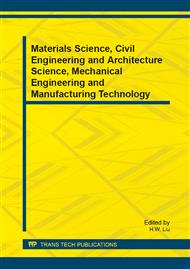p.377
p.381
p.385
p.390
p.394
p.398
p.403
p.407
p.411
Critical Seismic Response Analysis of Skew Bridges
Abstract:
The complexity of seismic response for skew bridge rises higher seismic-vulnerability relatively in comparison with right bridge. One of the parameters that directly affects the seismic response on a skew bridge is the excitation angle of the ground motion [. This paper investigates the effects of seismic force direction on the responses of skew bridges without considering impact effect in time history nonlinear dynamic analyses. The combination rules for orthogonal earthquake effects, such as the 100/ 30, 100/40 percentage rules and the SRSS method are also examined. It is concluded that the angle of excitation that produces the critical responses depends both on the ground motion and bridge characteristics, and the three combination rules are all relatively conservative, a new formula which considers the influence of skew angle and excitation angle of the ground motion is suggested.
Info:
Periodical:
Pages:
394-397
Citation:
Online since:
January 2014
Authors:
Price:
Сopyright:
© 2014 Trans Tech Publications Ltd. All Rights Reserved
Share:
Citation:


